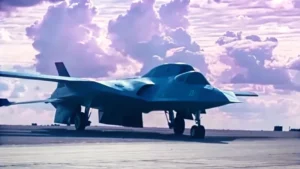It seems China has decided to reassemble the concept of a “fighter” from scratch. The photo of the J-36 reveals several details that clearly stand out from the usual scheme. It has an unusual cockpit, three engines, and internal bays for weapons. All this may indicate the creation of a multi-role stealth fighter.
A fresh photo of a new Chinese fighter jet, the J-36, has appeared on the Internet. If the photo is authentic, it shows a truly unusual detail: the cockpit has two seats, installed side by side, like in a bomber. This is rare for fighters. Usually, pilots sit one behind the other — this reduces air resistance. And here, the layout is like that of the Russian Su-34. This may indicate tasks that one pilot cannot handle — for example, in complex missions or when controlling sophisticated electronics.
The photo also reveals other features. Three internal weapons bays are visible under the fuselage. The central one is large, and there are two smaller ones on the sides. This means that a wide arsenal is located inside: from light missiles to heavy long-range charges. Previously, no one knew for sure whether the aircraft had side bays, but the photo confirms their presence.
The nose of the J-36 is covered with glass with a golden hue — most likely, these are windows for sensors and guidance systems. The smooth lines of the body and the special shape of the air intakes also indicate the intention to make the aircraft as invisible to radar as possible.
According to Chinese experts, the J-36 is larger and heavier than the current J-20 — its length can reach 23 meters, and its weight up to 54 tons. This puts it on par with multi-purpose stealth platforms such as the American B-21. Such aircraft can perform several tasks at once: strike, conduct reconnaissance, launch missiles at ground targets, etc.
In general, sixth-generation fighters still exist in the form of prototypes and concepts, but their appearance is already taking shape: these are aircraft with smooth, angular bodies without vertical tails, made according to the flying wing scheme or a merging fuselage and wing. They are almost always unmanned or capable of operating in two modes — with and without a pilot. Such machines are expected to be equipped with artificial intelligence, next-generation stealth technologies, hypersonic weapons, and the ability to control a group of drones directly in combat.

It turns out that China is working not just on a new fighter, but on a universal combat vehicle — one that will be able to perform both interception and long-range strike missions. If the development is completed successfully, Chinese aviation will become even more deadly, and the military balance in the air over the coming decades may shift toward Asia.
Earlier, we wrote about the presentation of the Phantom 3500 — a unique aircraft without windows.
